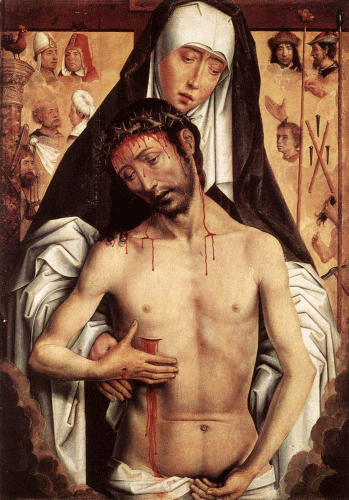Banner or Pop-Up Advertisements appearing on this website
click on the name of any prayer to read the words of that prayer
~ The Five Holy Wounds of Christ ~

~ The Five Holy Wounds of Christ ~

"Moreover, the Five Wounds of Christ are honoured by a Mass and an Office, and on account of these wounds we venerate also the feet, hands and side of the most loving Redeemer, these parts of Our Lord's most holy body being held more worthy of a special cult than the others, precisely because they suffered special pains for our salvation, and because they are decorated with these wounds as with an illustrious mark of love."
(Nikolaus Nilles, 1885)
Crucified, Our Lord Jesus Christ accepted five Holy Wounds: one in each foot, one in each hand, and one in His side & heart.
It was through the revival of religious life and the zealous activity of St. Bernard and St. Francis in the twelfth and thirteenth centuries, combined with the enthusiasm of the Crusaders returning from the Holy Land, which gave impetus for devotion to His Holy Wounds.
Many medieval prayers devoted to His Holy Wounds were written, including a Litany attributed to St. Clare of Assisi. Saints Mechtilde and Gertrude were also devoted to the Holy Wounds.
Praying in honor of the 5 Holy Wounds of Christ became a popular devotion throughout Europe. In 14th century Germany, fifteen Our Fathers were often recited every day in memory of of the Holy Wounds. Elsewhere it was customary to ring a bell at noon on Fridays, to remind the faithful to recite five Our Fathers and Hail Marys in remembrance of His Wounds.
There was even a special Mass in honour of Christ's Wounds, believed to have been composed by St. John the Evangelist and revealed to Boniface II. Known as the Golden Mass; during its celebration five candles were always lighted. It was popularly held that if anyone should say or hear it on five consecutive days he should never suffer the fiery pain of Hell.
~ The Chaplet of the Holy Wounds ~ The Passionst's Five Wounds Chaplet was first approved by a Decree of Pope Pius VII, dated January 22, 1822.
The first mention of the Five Wound Beads appears in 1821. The Platea of Sts. John and Paul, at Rome, relates that, "The Most Reverend Father General [of the Passionists], acting in accordance with our spirit to promote devotion to the Passion of Our Lord Jesus Christ, obtained permission to bless the Chaplet of the Five Wounds, at the same time enriching it with indulgences."
Praying the Chaplet was initially complicated - so it was revised into a simpler forum. The refined Chaplet was indulgenced by Pope Leo XII in 1823.
The requirements for gaining the indulgence were defined by the Holy Father in his Decree of Approval: "This Chaplet is a formula of prayer containing five sections of five beads each. On each bead one Glory be to the Father is said, and between the sections one Hail Mary in honor of the Sorrowful Virgin. During each of the sections the Wounds of Our Lord Jesus Christ are piously meditated upon."
The Chaplet of the Holy Wounds has remained unchanged to the present time.
While reciting the prayers, one contemplates each of Our Lord's Crucifixion Wounds.
Like the Holy Rosary, the prayers are the "body" of this Chaplet, while the meditations are its "soul."
In order to inspire deeper meditation, many devotees add short prayers in honor of the Wounds. While it is not necessary to do so, it can be very helpful.
The format of the Chaplet of the Holy Wounds presented here, as taught by a Passionst Priest, includes such additional prayers.
While there is no specified order in which His crucifixion Wounds must be ordered. However, the traditional Passionist's arrangement is...
The Holy Wound in His left foot.
The Holy Wound in His right foot.
The Holy Wound in His left hand.
The Holy Wound in His right hand.
The Holy Wound in His side & heart.
Many people are confused about the manner in which the Chaplet is prayed on the beads.This is because, while the beads are in a configuration similar to the Rosary and other Chaplets, the contemplations and prayers do not begin on the Medallions, but on the Glory Be beads - moving up, prayer-by-prayer, to that Wound's Medallion.
(Also, the "loop" is seomtimes arranged in "reverse," so that one moves clockwise around the Chaplet.)
The Chaplet is begun by making the The Sign of the Cross with the large Strand-Medallion.
(This is frequently followed by a Prayer of Contrition.)We then pray an Our Father, a Hail Mary and a Glory Be on the three Strand-beads, for the Holy Father's intentions.
Then we move to the chain extending above the Joiner-Medallion. Contemplating the 1st Holy Wound (usually His left foot) on the Medallion at the end of those 6 beads, we pray 6 Glory Bes (often preceded by additional Prayers.)
The Hail Mary (and any accompanying prayers) is then prayed at that Medallion.
Continuing around the Chaplet in this way, we end with the 5th Wound, at the Joiner-Medallion (usually His side & heart.)
The Chaplet is completed by again making the The Sign of the Cross.
The Chaplet of the Holy Wounds page linked below will open a page with audio, images and prayers - designed to enhance your contemplations His 5 Crucifixion Wounds ... with or without the use of beads.
It is my hope that you will be encouraged to take frequent advantage of this wonderful devotion.